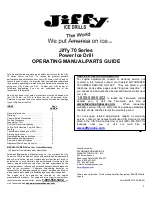
Page of 13
9
TRIGGER SWITCH ACTION
• Turn the drill on by depressing the trigger switch (4-FIG 1).
• Depressing the switch further will produce more speed and torque.
• Use the Reversing Switch (5-FIG 1) to change the direction of rotation of the drill.
• The Reversing Switch has three positions: Forward, Reverse, and Off (middle).
• Always check the rotation before beginning your work.
TWO-SPEED GEAR SWITCH (FIG 4)
• Slide the speed gear switch (A) to choose between
position 1 for low speed range (0-350 RPM) and
position 2 for high speed range (0-1,300 RPM).
• The low speed range has more power and torque.
Use the low speed range for high power and
torque applications.
• The high speed range is for fast drilling or driving
applications.
LED WORK LIGHT
Your tool has a built-in LED work light (6-FIG 1) to illuminate the work area. When you turn on the
tool, the work light will automatically turn on.
ELECTRIC BRAKE
This drill is equipped with an electric brake. Like the torque settings, an electric brake provides
you with another element of control during various operations. If the tool consistently fails to
quickly stop after trigger switch release, have a qualified serviceman examine the tool.
CHUCK (FIG 5)
• Your drill is equipped with a single sleeve keyless
chuck (1), so you can quickly change bits with no
extra tools required.
• To install bits, place the reversing switch in the Off
(middle) position. Rotate the chuck body
counter-clockwise to open the chuck jaws (2) to a
point where the opening is slightly larger than the
bit size you intend to use. Insert the bit. Tighten
the chuck jaws by rotating the chuck body
clockwise to secure the bit in place.































